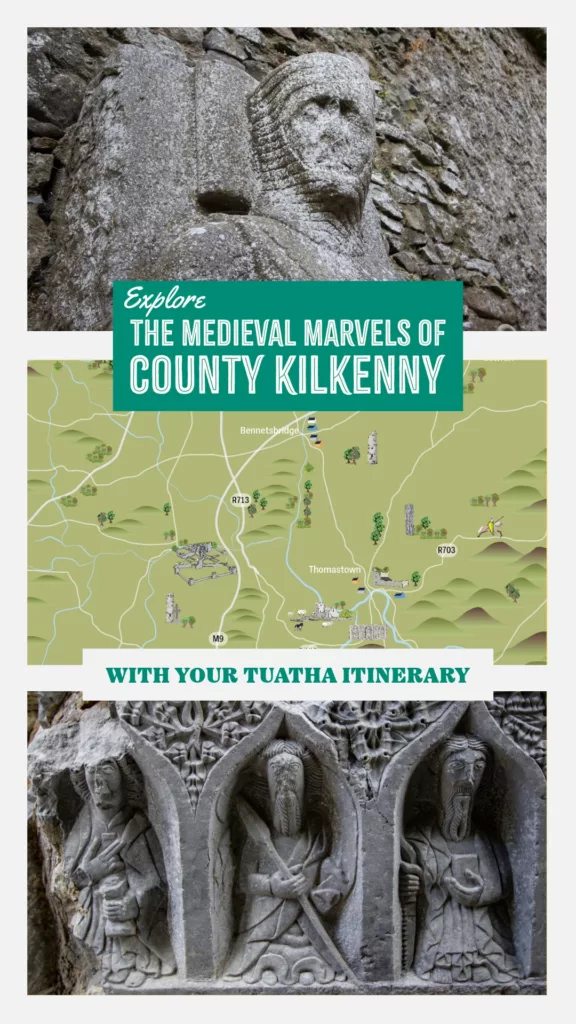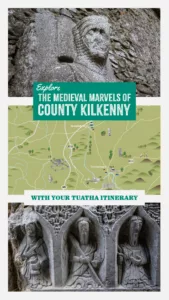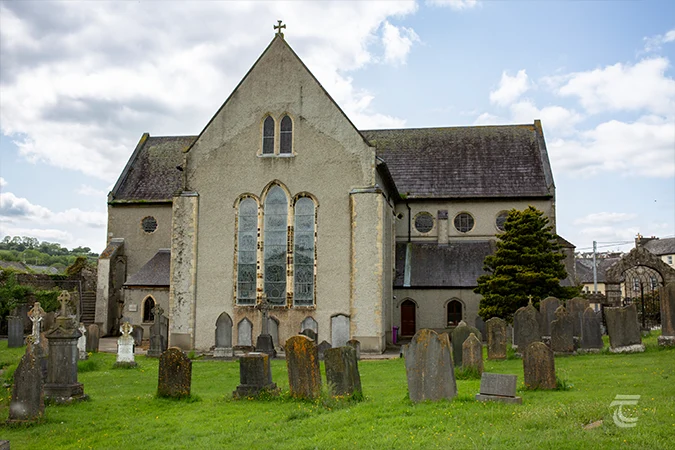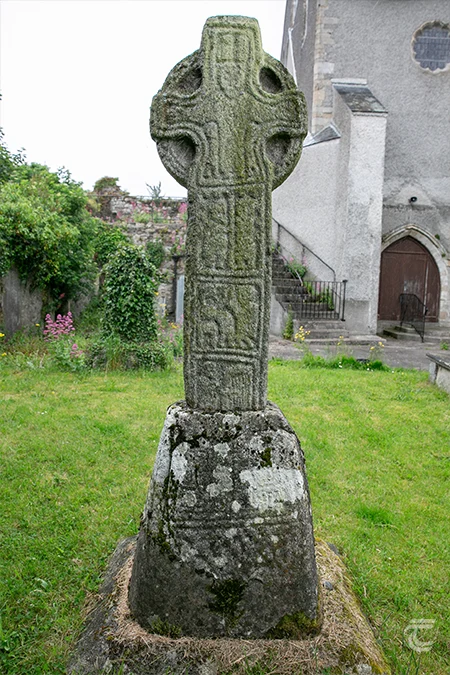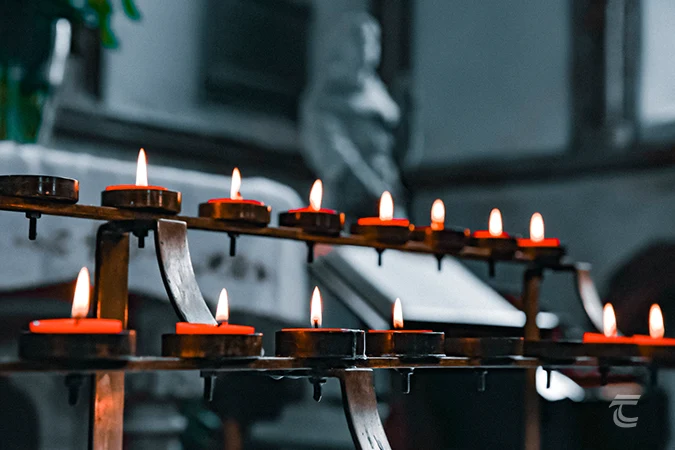Duiske Abbey
Duiske Abbey is one of the finest, and largest, Cistercian buildings still in use in Ireland, and the extensive cloister garth was only equalled by that of Dunbrody Abbey. The abbey was founded in 1204 by William Marshal. The First Earl of Pembroke, William Marshal (1146–1219) was undoubtedly one of the most influential figures in Irish history. He was a prolific builder of castles like Kilkenny and the Rock of Dunamase, towns like New Ross, and abbeys like Tintern, across his vast territories in Ireland, Wales, England and Normandy. He founded Duiske as a ‘daughter house’ to the Cistercian monastery of Stanley in Wiltshire, England. Though today it is known as Duiske Abbey, or in Irish Mainistir an Dubhuisce, its original Latin name was Vallis Sancti Salvatoris, or the Valley of the Holy Redeemer.
The community that settled at Duiske Abbey found it to be the perfect place for a life of contemplation and religious service, located in a picturesque setting in the shadow of Brandon Hill close to the Duiske River. It was the abbey that gave the nearby town its name, Graiguenamanagh, as it derives from the Irish Gráig na Manach, meaning ‘hamlet (or village) of the monks’. The Cistercians raised revenue through the wool trade, but by the end of the 13th century the abbey was recorded as being in serious debt, owing substantial sums to Italian bankers. However, the abbey endured and continued to flourish. The last abbot, Charles Kavanagh, was a generous benefactor, and donated much wealth to the abbey, including precious vestments and a silver gilt cross. He was also responsible for the creation of the ‘Annals of Duiske’ or ‘The Ancient Book of Graig’, which was set to paper in the Abbey’s scriptorium. He travelled on pilgrimage to Santiago de Compostela in 1530, though the abbey’s days were soon to end.
Three centuries of Cistercian life at the Abbey came to a crashing halt in 1536, when the Abbey was dissolved during the Reformation. Abbot Kavanagh was given a pension of £10 per year, though this turned out to be a costly payoff, as he lived to the grand old age of one hundred! A local tale recorded in the Schools’ Folklore Collection tells that some of the monks tried to remain in the Abbey after the dissolution. The story goes that they were hiding in a small vault under the dormitory when they were discovered by Queen Elizabeth’s soldiers. They were ordered to remove their sacred vestments, but the monks refused, saying it would be a denial of their faith. This inevitably sealed their fate, and twelve of them were slaughtered. The area where the incident occurred came to be known locally as the ‘Black Bout’.
For practical information about visiting this site Click Here
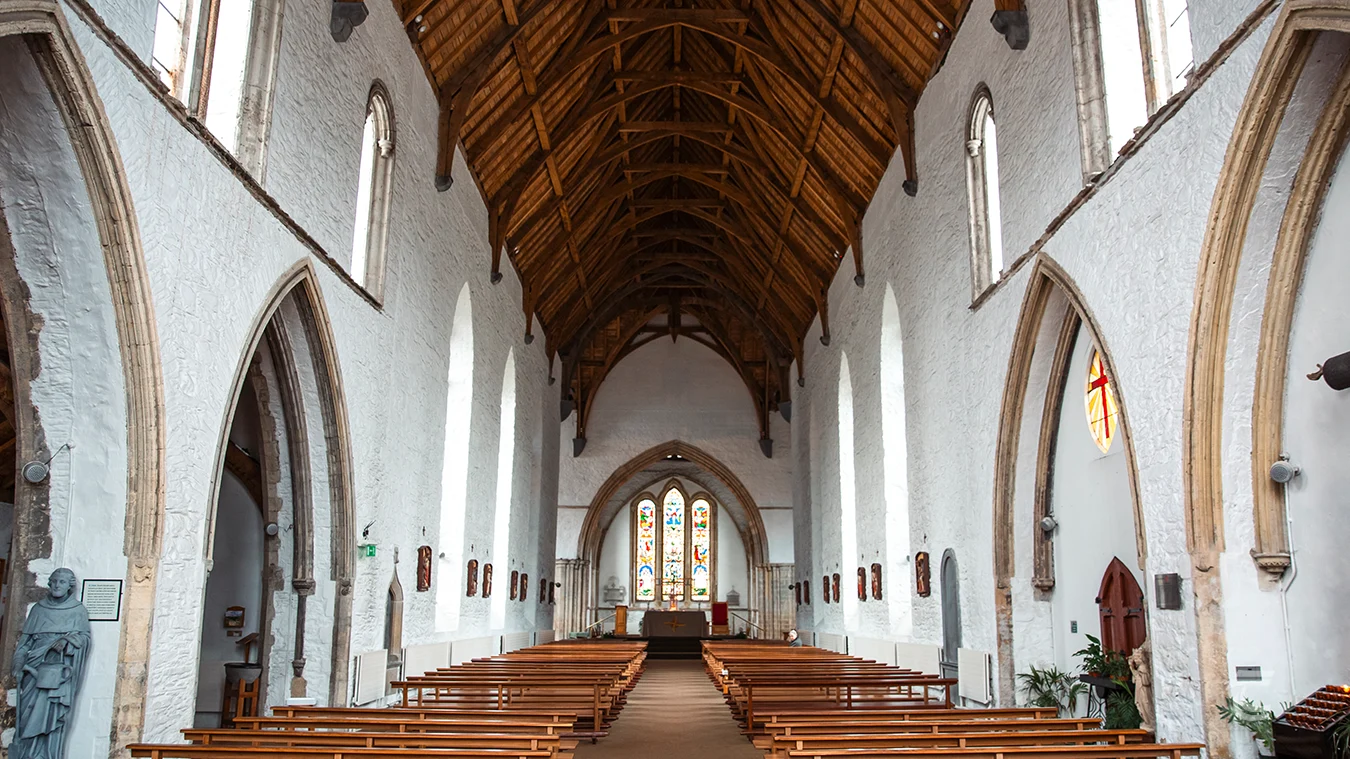
Aerial view of Corcomroe Abbey and the landscape of the Burren • Clare
The Later History of Duiske Abbey
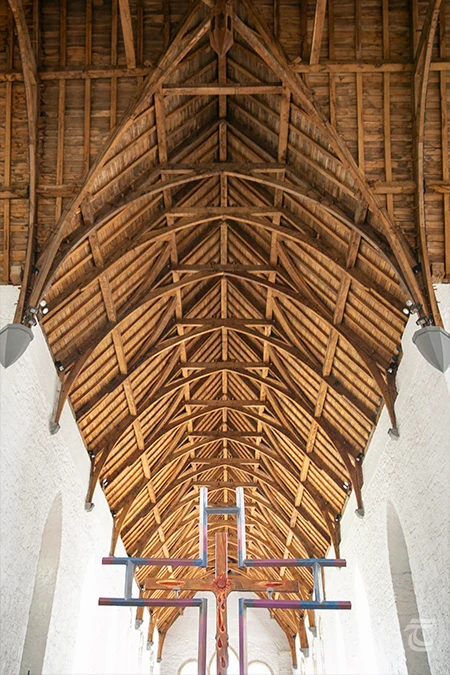
The roof was restored in the 1970s, made of Irish oak and elm • Duiske Abbey
After the dissolution, Duiske Abbey and its lands were granted to James Butler, the 9th Earl of Ormond. The Butlers held the property for 160 years, during which time Piers FitzThomas Butler reputedly turned the nave into a private residence. When the Jacobite Butlers fell out of favour with England’s new Dutch King, William of Orange, the Abbey was confiscated. It was later sold to James Agar. Although a Protestant, he believed the church had been ‘built by Catholics, for Catholic purposes and consequently should be restored to its rightful owners’ and so returned Duiske Abbey to the parish.
In 1813, the people of Graiguenamanagh began restoring this magnificent abbey to its former glory. Walking around this bright and atmospheric church today, it’s hard to imagine its appearance when they began their efforts. One contemporary account gives us an impression of its condition prior to the restoration:
‘[it is] occupied by a stable. Jackdaws build in the library; the refectory is used as a corn-store; the hoot of the owl may be heard in the dormitory; artificial manure is piled in the ancient kitchen; and the Royal Irish Constabulary practice goose-step in the cloister.’
Unfortunately not all of the Abbey’s features survived to be restored. The Abbey’s 36m high octagonal crossing tower had collapsed in 1774, destroying parts of the chancel vaulting, which was said to have been one of the finest in Ireland.
During the restoration in the 1970s archaeologists carefully excavated the floor, which was raised by 1.5m during earlier restoration. While excavating, they revealed some of the Abbey’s beautiful original 13th-century floor tiles, upon which the monks had walked. You can see these for yourself at the entrance to the church along with a fantastic model of Duiske Abbey in its heyday.
The tiles are not the only medieval remnants. The (sadly often locked) baptistry contains a fine medieval effigy tomb, that depicts a knight holding a sword. Though it was carved in Ireland, the style of armour is of a type that was highly fashionable in England. Elsewhere in the baptistry you can find an alabaster font and a stunningly carved 13th century processual doorway. Together they give an impression of the status and importance attached to the Abbey during the middle ages.

The roof was restored in the 1970s, made of Irish oak and elm • Duiske Abbey
Duiske Abbey Graveyard and High Crosses
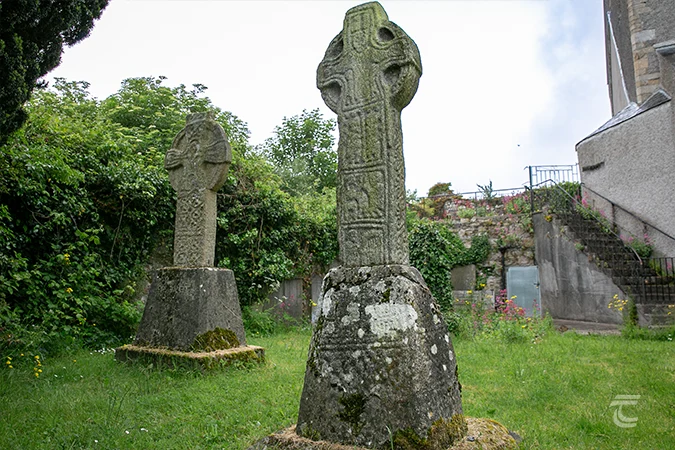
The Ballyogan (right) and Aghakiltawn (left) high crosses • Duiske Abbey
In the quiet graveyard behind Duiske Abbey, you will find two high crosses. Known as the Ballyogan and Aghakiltawn high crosses, they are believed to date to around the 8th–9th century. At over a thousand years old, they predate the Abbey by centuries. The weathered carvings on the Ballyogan Cross depict Adam and Eve, Isaac, the sacrificial child of Abraham, and King David and his lyre. The older Aghakiltawn cross, is decorated with an interlace design and bears a now faint depiction of the crucifixion. A medieval cross slab is built into the wall of the abbey, and there is also the base of a third cross in the abbey grounds.
Near the two high crosses—but separated by a millennium in time—you will find the Cheevers Memorial. This stone is dedicated to Captain Thomas Cheevers, one of the leaders of the United Irishmen during the 1798 Rebellion. Thomas fought at and survived the famous Battle of New Ross, but was killed later in the rising. His body was retrieved and brought to Duiske Abbey for burial in his family’s vault.
Though it appears quite simple from the outside, the interior of Duiske Abbey is one of the most atmospheric and fascinating places to visit in Ireland. It still plays a key role in the daily lives of the inhabitants of the charming town of Graiguenamanagh in south Kilkenny. You can hear more of the story of the abbey, and Graiguenamanagh, in a free Abarta audio guide that we produced with the local community. Available on your favourite podcast platform, or on the Abarta Heritage website.
Upper left: the exterior of the abbey church • Lower left: candles lit as a petition • Right: the Ballyogan Cross
Top: the exterior of the abbey church • Middle: the Ballyogan Cross • Bottom: candles lit as a petition
Explore more sites in Ireland’s Ancient East
